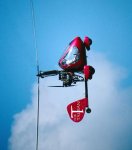Back when I was flying my RAF, it was impossible not to be aware of the shortcomings its HTL created. I enjoyed flying that machine, but flew respecting it not to be near as friendly should I unload the rotor by my action or had nature step in with a big downdraft. Maneuvers like the one that killed the pilot in the Frog RAF unfortunately have happened way too many times. Had he had CLT, he more than likely would not have bunted. Sure, you shouldn't be unloading your rotor like that in a zoom climb, but to unload your rotor with lots of power pushing at the distance an RAF's thrustline is offset, is a perfect recipe for a disaster. More than likely, if the pilot had flown it respecting its HTL, and understanding the physics of why, he would be still flying his RAF safely as do many others. Its the ones that don't understand what a HTL can do if you push it unloading the rotor. Too many have tumbled out of the skies while I was flying mine. When I started flying my SparrowHawk is when I could feel what stability was. I agree with the person that commented how Brian would notice the difference when he flies his Genesis. Stan


